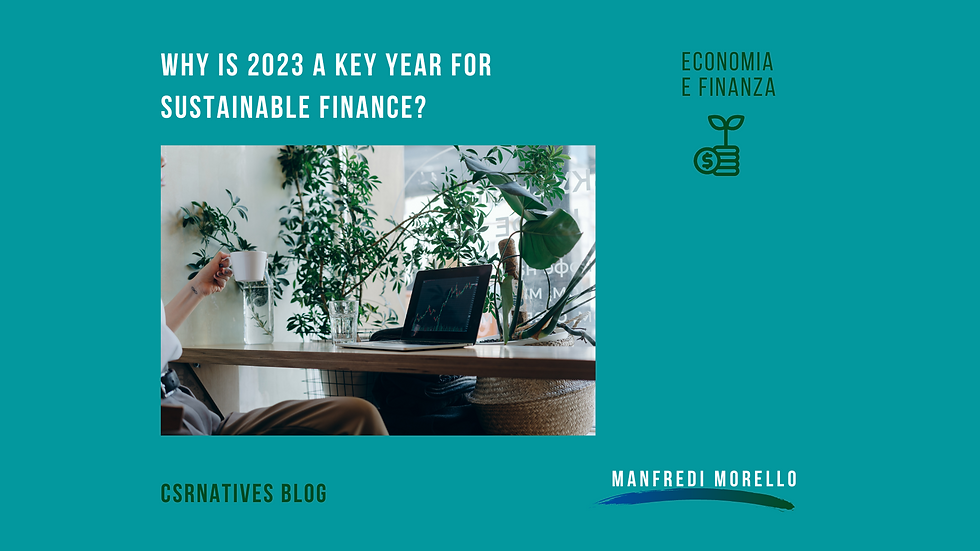A shade of blue for Sustainable Finance: the blue bonds
- CSRnative
- 28 set 2023
- Tempo di lettura: 3 min
Aggiornamento: 24 mag 2024
In one of our previously discussions on trends and issues for 2023 Sustainable Finance, we observed a raising trend for sustainable debt issuance. [1a] Data showed how Sustainable investment is bound to grow up again in 2023. When it comes to sustainable debt issuance, we can see much optimism from financial players: Morgan Stanley for instance had forecasted that blue bonds would have been bound to get over green bonds in the medium term [1b]. Blue bonds are debt instruments, whose use of proceeds are financing the Ocean preservation. Their median yearly volume is currently around 1.5 Billion USD and the majority of issuers are sovereign nations rather than companies [2] and this gives them an alleged long-term demand from subscribers, as Fidelity postulated. [3] and [4] We do not see any reason why this forecasts could not be true.
The incoming week marks the anniversary of the SDGs. In the framework of the UN Sustainable Development Goals, SDG 14 recognises the ocean as a key element in making our planet a habitable place for humans. According to scientists, rainfall, drinking water supply, climate, coastlines, much of our food and even the oxygen in the air we breathe depend on the sea. With limited space to demonstrate the importance of sustaining the oceans and water as a natural resource, we will focus on the role that sustainable finance and investment can play in promoting the UN, EU and OECD-driven international sustainability guidelines for the economy of the sea. [5, 6 and 7]
Climate change threatens the oceans, their ecosystems and biodiversity. While the task of defining coordinated responses lies with the above-mentioned international organisations, the "blue economy" presents itself as uncharted and promising territory for a more sustainable economic system. Blue bonds, a relatively new financial instrument, have the potential to play an important role in financing the blue economy and, of course, in achieving SDG 14. [8] Blue bonds are aligned with the European Commission's Sustainable Ocean Financing Strategy, UNEP's Blue Economy principles and the World Bank's Environmental and Social Sustainability Performance Standards.
Although they still lack a definition of their own, blue bonds can be classified as ESG-linked or "green" issues depending on the structure of the financing. [9] When the debt issue finances an infrastructure project for the maintenance and protection of the oceans, and the use of the proceeds is certified by an ESG rating agency or other independent agent, they are similar to green bonds. On the other hand, blue bonds resemble ESG-linked debt when the proceeds of the financing are unrestricted, giving the issuer greater freedom in the use of the funds raised. However, in the latter case, concerns arise for the ESG Rating Agency Standard Ethics. ESG-linked issues generally lack feedback on the company's use of the proceeds raised in the market, which may lead to a misleading assessment by investors and the market, and therefore not generate the impact initially intended. [10]
Protecting our oceans is essential. If we clearly define blue bonds and harness their potential quickly, these new sustainable finance tools could help us improve our economic systems. They could mobilize capital for companies and economic actors to invest in more effective infrastructure to protect the planet and meet the needs of future generations.
Sources:
[1a] Manfredi Morello - Why is 2023 a key year for sustainable finance?, CSRnatives Blog. URL: https://www.csrnatives.net/post/why-is-2023-a-key-year-for-sustainable-finance
[1b] Morgan Stanley - Institute for Sustainable Investing, Blue Bonds: The Next Wave of Sustainable Bonds. URL: https://www.morganstanley.com/content/dam/msdotcom/ideas/blue-bonds/2583076-FINAL-MS_GSF_Blue_Bonds.pdf
[2] The UN Global Compact - Blue Bonds: accelerating sustainable Ocean business. URL: https://unglobalcompact.org/take-action/ocean/communication/blue-bonds-accelerating-sustainable-ocean-business
[3] Bosmans P, de Mariz F. The Blue Bond Market: A Catalyst for Ocean and Water Financing. Journal of Risk and Financial Management. 2023; 16(3):184. https://doi.org/10.3390/jrfm16030184
[4] Fidelity - Analysis and Research, Blue bonds and the ocean funding gap. URL: https://www.fidelity.com.sg/articles/analysis-and-research/2023-06-08-blue-bonds-and-the-ocean-funding-gap-1686279234140?&utm_campaign=2023_si&utm_medium=owned_social&utm_source=linkedin&utm_term=thought_leadership&utm_content=video
[5] World Bank Group - International Finance Corporation, Guidelines for Blue Finance Guidance for financing the Blue Economy, building on the Green Bond Principles and the Green Loan Principles.URL: https://www.icmagroup.org/assets/documents/Sustainable-finance/Learning-resources/IFC-Blue-Finance-Guidance-Document_January-2022-270122.pdf
[6] EU Commission, The Blue Economy Report 2022 https://op.europa.eu/s/y0zp
[7] OECD 2022 – Work in support of Sustainable Oceans https://www.oecd.org/environment/2022-OECD-work-in-support-of-a-sustainable-ocean.pdf
[8] Caixabank Blog - Blue bonds, la última innovación ecológica del mercado financiero. URL: https://blog.caixabank.es/blogcaixabank/blue-bonds-la-ultima-innovacion-ecologica-del-mercado-financiero/
[9] Banco Santander - Blue bonds: the value of conserving marine ecosystems. URL: https://www.santander.com/en/stories/blue-bonds#:~:text=In%20order%20to%20issue%20these,a%20means%20of%20attracting%20financing
[10] Standard Ethics - Research Office - A brief analysis of 60 General-Purpose Bond issues under Security Standard Ethics Rating and the case of Snam and its ESG Euro-Commercial Paper Programme. URL: https://standardethics.eu/media-en/research-methodology/research-report-all-debt-must-be-sustainable/viewdocument/495






Commenti